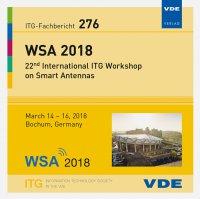Scheduling Strategies for Hierarchical Beamforming in Cloud RAN
Conference: WSA 2018 - 22nd International ITG Workshop on Smart Antennas
03/14/2018 - 03/16/2018 at Bochum, Deutschland
Proceedings: WSA 2018
Pages: 8Language: englishTyp: PDF
Personal VDE Members are entitled to a 10% discount on this title
Authors:
Boiadjieva, Boriana; Al-Shatri, Hussein; Klein, Anja (Communications Engineering Lab, Technische Universität Darmstadt, Merckstr. 25, 64283 Darmstadt, Germany)
Abstract:
In this paper, we consider the downlink of a multicellular multiuser system with cloud radio access network (CRAN) and study the user scheduling with hierarchical beamforming which maximizes the system sum rate. To reduce the signaling over the capacity limited fronthaul, we feed the cloud only with long-term statistical channel information. Therefore, we use theorems from random matrix theory to define tight analytical approximation of the data rate at every user. Hence, we split the preprocessing between cloud and base stations (BSs) to allow intra-cell and inter-cell interference management and apply hierarchical beamforming designed partly at the cloud and partly at the BS. Having this split, we posed the intuitive questions where and how the user scheduling should be applied and study which strategy can provide us with the best trade-off between achieved system sum rate performance and required execution time. Since the optimal solution will require high computational complexity as well as a big amount of signaling over the fronthaul, we investigate diverse suboptimal schemes for user scheduling at the cloud and at the BSs. The proposed schemes have the objective to maximize the system sum rate. Interestingly, although based only on statistical knowledge, simulation results demonstrate that the scheduling at the cloud outperforms scheduling at the BSs since it allows coordination for interference management between the BSs and so it achieves higher system sum rate while keeping the computational time low.


